Android 3.2 on the ASUS Eee Pad Transformer: Tested
by Anand Lal Shimpi on August 3, 2011 2:43 AM ESTBack in June, Google announced that Android 3.2 would be arriving beginning this summer for Honeycomb tablets. Motorola, being Google's launch partner for Honeycomb, was first to get the update. Next on the list was ASUS and as of late last week, Eee Pad owners in the US started getting their version of Android 3.2. I updated my Eee Pad over the weekend and the process went seamlessly. As long as you've got more than 25% left on your battery you're good to go. If you haven't updated your Eee Pad since the launch you'll need two updates to get to 3.2.
The 3.2 update on the Eee Pad brings about a new splashscreen as well as a TegraZone app. TegraZone is NVIDIA's custom marketplace that leverages the Android Market. TegraZone is used exclusively for games that are optimized for NVIDIA's Tegra 2 SoC.
The update itself is relatively minor from a feature standpoint. The version notes help explain the changes:
- Optimizations for a wider range of tablets
Android 3.2 includes a variety of optimizations across the system to ensure a great user experience on a wider range of tablet devices.
- Compatibility zoom for fixed-sized apps
Android 3.2 introduces a new compatibility zoom mode that gives users a new way to view fixed-sized apps on larger devices. The new mode provides a pixel-scaled alternative to the standard UI stretching for apps that are not designed to run on larger screen sizes, such as on tablets. The new mode is accessible to users from a menu icon in the system bar, for apps that need compatibility support.
- Media sync from SD card
On devices that support an SD card, users can now load media files directly from the SD card to apps that use them. A system facility makes the files accessible to apps from the system media store.
The first point is rather vague but the big news is of course the second point on the list. Modern Android smartphones run at one of three native resolutions: 800 x 480, 854 x 480 or 960 x 540. Honeycomb tablets on the other hand all run at 1280 x 800. What happens when you run an app optimized for the display resolution of an Android smartphone on a Honeycomb tablet? Many apps just expand to fit the screen. If they were optimized for one of the aforementioned resolutions, they just stretch by adding more horizontal/vertical resolution until they occupy the entire viewport. Here's an example using the SystemPanel app, an AnandTech favorite:
To the left we have SystemPanel running at 800 x 480 on an Android smartphone, and to the right we have it running at 1280 x 800 on the Eee Pad Transformer. The UI just scales up. Now take a look at the Speedtest app:
It doesn't scale up, it's hard coded to an 800 x 480 resolution and appears as such in the center of our Eee Pad. Android 3.2 addresses this very problem with its compatibility zoom feature:
Here's the same Speedtest app but with the zoom control set to...zoom:
If you click to enlarge the image above you'll see it's not particularly pretty (interpolated scaling rarely is) but it does completely fill the screen.


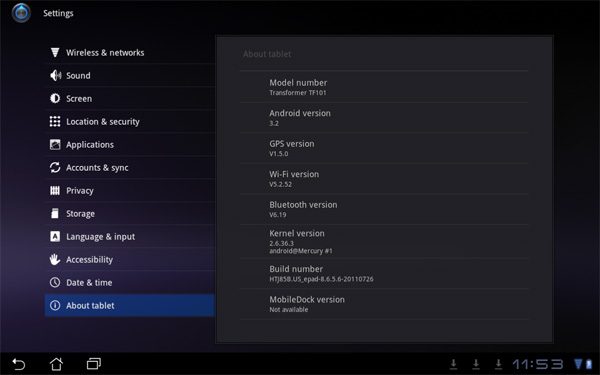
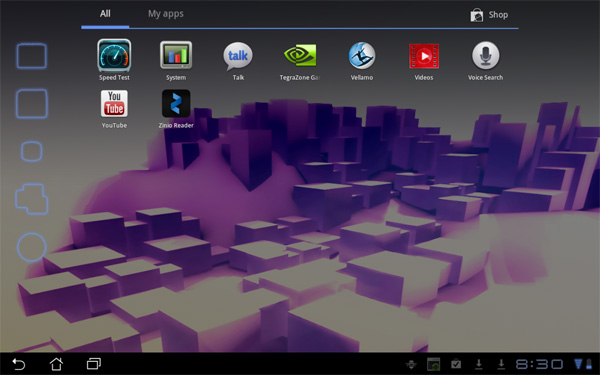
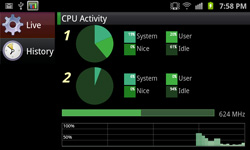
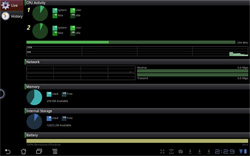

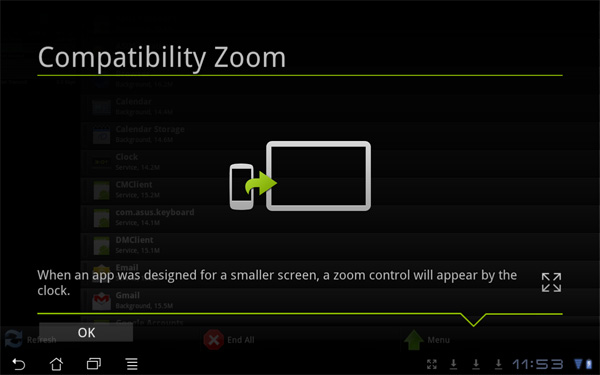
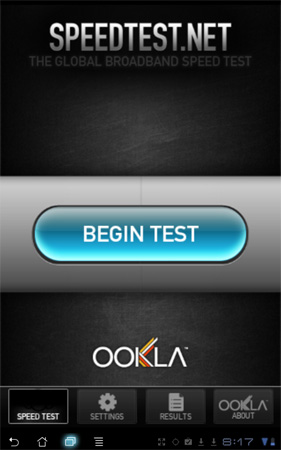








30 Comments
View All Comments
etobare - Wednesday, August 3, 2011 - link
excuse me but are you saying that the omap 4470 will make the A5 seem slow? or the other way around?i was thinking about that, i got a droid 3 knowing that my gpu is a sgx540, and that will be slower that a possible a5 equipped iphone, but on a phone it's not a big deal (for me), but for tablets, i really want the best SoC possible and OMAP4 seems a little weak GPU-wise, remember that OMAP3 went its entire life using SGX530 while iphones and galaxys went to 535 and 540
etobare - Wednesday, August 3, 2011 - link
duh, i just read about 4470 having a sgx544, good for them, disregard my previous commentsnoozemode - Wednesday, August 3, 2011 - link
Anand, thanks for great reviews, It would be very interesting with a recurring shootout and comparison of the latest and greatest SoCs from the big 5, Qualcomm, TI, Nvidia, Samsung and Apple, in other words not focusing on any specific device and maybe use performance numbers from several devices that uses the same SoC and make an average out of it.In essence I would like to see a bit of the old anandtech.
JasonInofuentes - Thursday, August 4, 2011 - link
So, this would be great, and with the variety of SoCs about to premier on tablets this Fall we might be able to do this sort of comparison. Unfortunately there will always be some variations within the standard including something as simple as the OS build. If you pay attention to benchmarks, as Android 2.x iterated their browser benchmark values improved tremendously, such that my OG Droid at 1GHz running CM7 with Gingerbread competes on Browsermark with far more powerful hardware running Froyo.So, it's almost impossible to account for all of the variables and compare these SoC's on equal footing. That doesn't mean we won't try though! :)
vision33r - Wednesday, August 3, 2011 - link
Some of the features added are nifty but quite useless. The biggest problem are the freezes, the battery drain still there. How can TF + dock last less than 7 hours during sleep. I can leave the iPad 2 sleep for 3-4 days and still have 40% battery.WIFI is very problematic now, it doesn't want to work 1/2 the time and can't reconnect.
The graphics seems snappier but most of the games I play aren't optimized for Tegra 2 so it's not good enough.
darkhawk1980 - Thursday, August 4, 2011 - link
Call Asus technical support. There is a known issue with the dock's that causes the dock's battery to drain even while the unit is off, specifically the dock isn't turning off the power to the keyboard and other devices when the transformer is put into sleep mode. But keep in mind, this is a DOCK problem, not a tablet problem. You should only need to return your dock to have the problem fixed. Check the xda developer forums for more information regarding the issue. Asus technical support is active in the forums and has provided support for those people there (which is more than I can say about a few other companies when it comes to support).Your wifi issue can be resolved by setting a static IP instead of allowing a dynamic IP to be set. You have to set it on the tablet though, not setup a static IP on your router for it. There's an issue with the transformer (and currently ALL honeycomb 3.2 devices) trying to renew the ip lease every few minutes.
sidprak - Thursday, August 4, 2011 - link
I believe the TegraZone app and new boot screen were added in version 3.1. I had those on my tablet before I updated to 3.2amankumar - Thursday, August 4, 2011 - link
free HD android games full:http://nitin-xyz.blogspot.com/2011/07/free-and-ful...
rupaniii - Thursday, August 4, 2011 - link
Uhm, just look at it... I know this is about Pinch To Zoom, but, uhm, that's a new meaning to the thing, LOL.dasiel - Friday, March 30, 2012 - link
The first point is rather vague but the big news is of course the second point on the listhttp://google.com